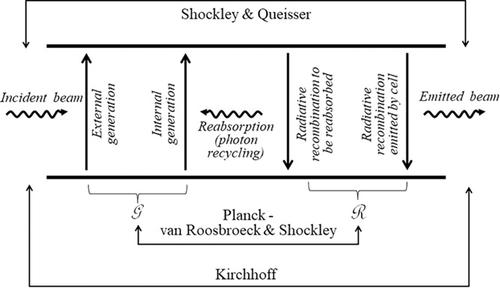Shockley: Queisser detailed balance limit after 60 years
IF 5.4
3区 工程技术
Q2 ENERGY & FUELS
引用次数: 6
Abstract
The year 2021 marks the 60th anniversary of the Shockley–Queisser paper which laid the theoretical foundations for the fundamentals of solar cell operation. This article reviews the principal results of the Shockley‐Queisser paper and the developments that followed. Starting with links to the earlier radiative balance laws of Kirchhoff and Planck, we discuss the nature of the detailed balance between the incident and emitted photon beams. The resulting efficiency limit is juxtaposed with another popular limit due to Trivich and Flinn. The dependence of the Shockley–Queisser limit on the intensity and sizes (étendues) of the two beams—in other words, on the concentration of sunlight—is discussed in some detail. This article then takes a broader view of the detailed balance with the help of the generalized Planck law and the refinements that this implies for the efficiency and the current–voltage characteristic of the cell. A natural extension of the Shockley–Queisser detailed balance into the realms of thermodynamics is outlined by considering the photon entropy in the two beams. This produces the detailed balance limit in a typical thermodynamic form, similar to the result for a heat engine, where the efficiency losses are expressed in terms of entropy generation. The paper concludes with a brief discussion of how the results can be extended to the operation of practical solar cells with a more realistic description of light absorption and nonradiative recombination. A brief overview is also given of mechanisms for how the Shockley–Queisser limit can be exceeded.

Shockley:Queisser详细的60后余额限制 年
2021年是Shockley-Queisser论文发表60周年,该论文为太阳能电池的基本原理奠定了理论基础。本文回顾了Shockley - Queisser论文的主要结果以及随后的发展。从基尔霍夫和普朗克早期的辐射平衡定律的联系开始,我们讨论了入射和发射光子光束之间详细平衡的本质。由此产生的效率限制与特里维奇和弗林提出的另一个流行的限制并列。文中还详细讨论了肖克利-奎瑟极限对两束光的强度和大小的依赖性——换句话说,对太阳光的浓度的依赖性。然后,本文在广义普朗克定律的帮助下,对详细的平衡进行了更广泛的观察,并对电池的效率和电流-电压特性进行了改进。通过考虑两束光束中的光子熵,将肖克利-奎塞尔详细平衡自然扩展到热力学领域。这产生了典型热力学形式的详细平衡极限,类似于热机的结果,其中效率损失以熵产生的形式表示。本文最后简要讨论了如何将结果推广到实际太阳能电池的操作中,并对光吸收和非辐射复合进行了更真实的描述。简要概述了如何超越Shockley-Queisser极限的机制。
本文章由计算机程序翻译,如有差异,请以英文原文为准。
求助全文
约1分钟内获得全文
求助全文
来源期刊

Wiley Interdisciplinary Reviews-Energy and Environment
ENERGY & FUELS-
CiteScore
11.70
自引率
3.30%
发文量
42
期刊介绍:
Wiley Interdisciplinary Reviews: Energy and Environmentis a new type of review journal covering all aspects of energy technology, security and environmental impact.
Energy is one of the most critical resources for the welfare and prosperity of society. It also causes adverse environmental and societal effects, notably climate change which is the severest global problem in the modern age. Finding satisfactory solutions to the challenges ahead will need a linking of energy technology innovations, security, energy poverty, and environmental and climate impacts. The broad scope of energy issues demands collaboration between different disciplines of science and technology, and strong interaction between engineering, physical and life scientists, economists, sociologists and policy-makers.
 求助内容:
求助内容: 应助结果提醒方式:
应助结果提醒方式:


